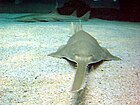List of threatened, endangered and extinct species in the Mariana Islands
The following is a list of species (or subspecies) in the Mariana Islands, defined by the International Union for Conservation of Nature (IUCN) Red List or by the U.S. Fish & Wildlife Service (USFWS), as being extinct, critically endangered, endangered, threatened, vulnerable, conservation dependent, or near threatened. This article addresses species found in the geopolitical states of Guam and the Commonwealth of the Northern Mariana Islands (CNMI).
As of 2024, there were 32 species or subspecies in the Mariana Islands listed by the U.S. Fish & Wildlife Service as endangered or threatened. USFWS has cited threats to species from habitat loss and degradation; military activities; urbanization; recreational vehicles; nonnative animals such as feral ungulates (wild boar and sambar deer), water buffalo, rats, brown tree snakes, slugs, flatworms, ants, and wasps; nonnative plants; fires; typhoons; water extraction; and future climate change.[1]
As of 2024, the USFWS and IUCN together listed 9 species or subspecies endemic to the Mariana Islands that have gone extinct: the little Mariana fruit bat (Pteropus tokudae); 5 birds (Guam flycatcher (Myiagra freycineti), bridled white-eye (Zosterops conspicillatus conspicillatus), Pagan reed-warbler (Acrocephalus yamashinae), Aguijan reed-warbler (Acrocephalus nijoi), the Mariana mallard (Anas oustaleti); and 3 snails (Partula desolata, Partula langfordi, Mount Alifana partula (Partula salifana)).[2] Archaeological evidence has revealed another snail from Guam, the Partula desolata, to be extinct.[3] Four undescribed and extinct bird species were excavated from Rota.[4] Additionally, the Guam kingfisher (Todiramphus cinnamominus) is listed by the IUCN as extinct in the wild.[5]
Mammals
[edit]| Common name | Scientific name | Image | US Fish & Wildlife conservation status | IUCN Red List status | Notes |
|---|---|---|---|---|---|
| Little Mariana fruit bat, Guam flying fox | Pteropus tokudae | Extinct (USFWS)[6] | Extinct (IUCN)[7] | Native to Guam. Last seen 1968; declared extinct in 2020 by IUCN, and 2023 by USFWS.[6] | |
| Pacific sheath-tailed bat (payeyi, paischeey) | Emballonura semicaudata rotensis | Endangered (Marianas subspecies, USFWS)[8] | Endangered (IUCN)[9] | Subspecies native to Guam and CNMI[8] | |
| Mariana fruit bat (fanihi, Mariana flying fox) | Pteropus mariannus mariannus |  |
Threatened (listed as Pteropus mariannus mariannus, USFWS)[10] | Endangered (listed as Pteropus mariannus, IUCN)[11] | Native to Guam and CNMI[10] |
Amphibians and Reptiles
[edit]| Common name | Scientific name | Image | US Fish & Wildlife conservation status | IUCN Red List status | Notes |
|---|---|---|---|---|---|
| Slevin's skink, Mariana skink (gualik halumtanu, gholuuf) | Emoia slevini | 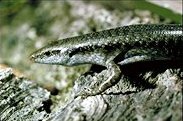 |
Endangered (USFWS)[12] | Critically Endangered (IUCN)[13] | Native to Guam and CNMI[12] |
| Micronesia saw-tailed gecko | Perochirus ateles |  |
Vulnerable (IUCN)[14] | Possibly extinct from Guam and Marcus Island. Found in Federated States of Marshall Islands; Japan; Micronesia; Northern Mariana Islands.[14] |
Endemic birds
[edit]Significant loses of bird species have likely occurred in the Mariana Islands in the past few millennia. A 1990 excavation of a late Holocene archeological site on Rota revealed the presence of 21 bird species, 12 of which have since become extinct or extirpated from Rota. Four of the species were not yet described and extinct: a small probably-flightless duck (Anatidae species), a giant ground-dove (Gallicolumba species), a large parrot (Psittacidae species), and a large parrotfinch (Erythrura).[4]
The endemic birds of Guam, the southernmost Mariana island, were severely affected by the introduction of the brown tree snake after World War II. Since then, 11 of Guam's 14 terrestrial bird species have become extinct or extirpated from Guam. Only 3 species still exist in the wild on Guam (Micronesian starling, Mariana gray swiftlet and yellow bittern).[15]
| Common name | Scientific name | Image | US Fish & Wildlife conservation status | IUCN Red List status | Notes |
|---|---|---|---|---|---|
| Pagan reed-warbler | Acrocephalus yamashinae | Extinct (IUCN)[16] | Native to Pagan. Last seen in late 1970s.[17] | ||
| Mariana mallard, Oustalet's duck | Anas oustaleti |  |
Extinct (USFWS)[18] | Native to Guam, Tinian and Saipan, possibly also Rota and Pagan. Last seen in 1979.[18] | |
| Bridled white-eye (nossa) | Zosterops conspicillatus
(listed by UWFWS as Zosterops conspicillatus conspicillatus) |
Extinct (USFWS)[6] | Extinct (IUCN)[19] | Endemic to Guam and considered one of the most common bird species between early 1900s and 1930s. Last seen in 1983; declared extinct by USFWS and IUCN in 2023[20] | |
| Aguiguan reed-warbler | Acrocephalus nijoi | Extinct (IUCN)[21] | Native to Aguiguan. Last seen in 1995.[22] | ||
| Guam flycatcher, Guam broadbill (CHuguangguang)[15] | Myiagra freycineti |  |
Extinct (IUCN)[23] | Native to Guam. Last seen in 1984.[18] | |
| Nightingale reed warbler, Guam reed-warbler | Acrocephalus luscinius
(spelling per IUCN); listed by USFWS as Acrocephalus luscinia) |
 |
Endangered (USFWS)[24] | Extinct (IUCN)[25] | Native to Guam.[26] Last seen in 1969.[27] |
| Guam kingfisher (sihek) | Todiramphus cinnamominus[28] |  |
Endangered (USFWS)[26] | Extinct in the Wild (IUCN)[29] | Native to Guam[26] |
| Guam rail (ko'ko')[28] | Gallirallus owstoni[28] (species name as listed by USFWS), Hypotaenidia owstoni (species name as listed by IUCN) | 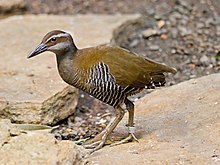 |
Endangered. Previously listed as Extinct in the Wild.(USFWS)[26] | Critically Endangered (IUCN)[30] | Native to Guam[26] |
| Saipan reed-warbler | Acrocephalus hiwae |  |
Critically Endangered (IUCN)[31] | Native to Saipan and Alamagan (CNMI)[31][32] | |
| Rota white-eye (nosa' Luta)[28] | Zosterops rotensis |  |
Endangered (USFWS)[26] | Critically Endangered (IUCN)[33] | Native to Rota (CNMI)[33] |
| Mariana crow (åga)[28] | Corvus kubaryi |  |
Endangered (USFWS)[28] | Critically Endangered (IUCN)[34] | Extinct from Guam; extant on Rota (CNMI)[34] |
| Micronesian megapode (sasangat)[28] | Megapodius laperouse |  |
Endangered (USFWS)[26] | Near Threatened (IUCN)[35] | Native to Mariana Islands and Palau[26] Extinct on Guam. Extant in CNMI and Palau.[35] |
| Mariana common moorhen (pulattat)[28] | Gallinula chloropus guami | Endangered (USFWS)[26] | Native to Guam and CNMI[26] | ||
| Mariana gray swiftlet[28] | Aerodramus vanikorensis bartschi | Endangered (USFWS)[26] | Native to Guam and CNMI[26] | ||
| Mariana swiftlet (yayaguak) | Aerodramus bartschi | Endangered (USFWS)[26] | Vulnerable (IUCN)[36] | Native to Guam and CNMI[26] | |
| Golden white-eye | Cleptornis marchei | 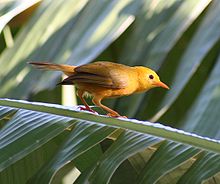 |
Endangered (IUCN)[37] | Native to CNMI[37] | |
| Saipan White-eye | Zosterops saypani | Near Threatened[38] | Native to Rota, Tinian and Saipan[38] | ||
| Mariana Fruit-dove | Ptilinopus roseicapilla |  |
Near Threatened (IUCN)[39] | Extinct from Guam. Extant in CNMI[39] | |
| White-throated ground-dove | Pampusana xanthonura |  |
Near Threatened (IUCN)[40] |
Migratory birds
[edit]| Common name | Scientific name | Image | US Fish & Wildlife conservation status | IUCN Red List status | Notes |
|---|---|---|---|---|---|
| Short-tailed albatross | Phoebastria albatrus |  |
Endangered (USFWS)[41] | Vulnerable (IUCN)[42] | Native to North Pacific Ocean, mostly breeding on islands near Japan[42] |
| Far eastern curlew | Numenius madagascariensis |  |
Endangered (IUCN)[43] | Breeds in eastern Asian Russia and Mongolia, but extant in coastal eastern Asia and western Pacific[43] | |
| Siberian sandplover | Charadrius mongolus |  |
Endangered (IUCN)[44] | Breeds in Australia, New Zealand and Russia, wintering in east Asia and western Pacific[44] | |
| White-necked petrel | Pterodroma cervicalis |  |
Vulnerable (IUCN)[45] | Breeds in New Zealand, Norfolk Island and Vanuatu; extant in other Pacific islands, Australia, and Mexico[45] | |
| Juan Fernandez petrel | Pterodroma externa |  |
Vulnerable (IUCN)[46] | Breeds in Chile; extant in French Polynesia, Guam, Mexico and Hawaii[46] | |
| Stejneger's petrel | Pterodroma longirostris |  |
Vulnerable (IUCN)[47] | Breeds in Chile; extant in French Polynesia, Guam, Japan, Marshall Islands, Federated States of Micronesia, CNMI[47] | |
| Common pochard | Aythya ferina |  |
Vulnerable (IUCN)[48] | Widespread in Europe, Asia and northern Africa; non-breeding in Guam and CNMI[48] | |
| Sharp-tailed sandpiper | Calidris acuminata |  |
Vulnerable (IUCN)[49] | Breeds in Russia; extant in Asia and western Pacific[49] | |
| Leach's storm-petrel | Hydrobates leucorhous |  |
Vulnerable (IUCN)[50] | Native throughout the oceans, non-breeding in the Mariana Islands[50] | |
| Matsudaira's storm-petrel | Hydrobates matsudairae |  |
Vulnerable (IUCN)[51] | Breeds in Japan; migrates from eastern African coast to western Pacific[51] | |
| Bar-tailed godwit | Limosa lapponica | 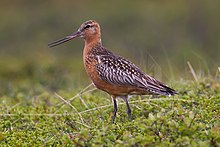 |
Near threatened (IUCN)[52] | Breeds in Russia and Alaska, extant in numerous other areas, including Guam and CNMI[52] | |
| Grey-tailed tattler | Tringa brevipes |  |
Near threatened (IUCN)[53] | Breeds in Mongolia; extant in Southeast Asia, Oceania and western Pacific Ocean[53] |
Gastropods
[edit]Three of the 7 partulid snails described from the Mariana islands are extinct, and the remaining 4 are imperiled.[54] Partulid populations have been affected by invasive snails such as the North American Euglandina species and the New Guinea flatworm (Platydemus manokwari).
| Common name | Scientific name | Image | US Fish & Wildlife conservation status | IUCN Red List status | Notes |
|---|---|---|---|---|---|
| Mount Alifana partula | Partula salifana |  |
Extinct (IUCN)[55] | Native to the Mount Alifana region of southern Guam[55] | |
| Partula desolata |  |
Extinct. Known only from an archeological site on Rota (although no indication that there was any human consumption of the snails). The species survived until at least c. 1000. The describing authors chose the specific name "desolata" due to the desolation brought about upon the Partulidae populations in the Pacific.[3] | |||
| Langford's tree snail (akaleha', denden) | Partula langfordi |  |
Endangered (USFWS)[56] | Extinct (IUCN)[57] | Native to Aguigan[56] |
| Succinea quadrasi | Species was being evaluated for protected status by USFWS in 1994.[58] | Endangered (IUCN)[59] | Native to Guam[59] | ||
| Succinea piratarum | Species was being evaluated for protected status by USFWS in 1994.[58] | Endangered (IUCN)[60] | Native to Guam[60] | ||
| Fragile tree snail, akaleha dogas, denden | Samoana fragilis |  |
Endangered (USFW)[61] | Endangered (IUCN)[62] | Native to Guam and Rota[61] |
| Humped tree snail (akaleha', denden) | Partula gibba |  |
Endangered (USFWS)[56] | Endangered (IUCN)[63] | Native to Guam and CNMI[56] |
| Guam tree snail (akaleha', denden) | Partula radiolata |  |
Endangered (USFWS)[56] | Endangered (IUCN)[64] | Native to Guam[56] |
Gastropods proposed to have protected status
[edit]- Partula lutaensis - endemic to Rota; species first described in 2021 and the describing authors advised it be "listed as Endangered as soon as possible."[54]
Insects
[edit]| Common name | Scientific name | Image | US Fish & Wildlife conservation status | IUCN Red List status | Notes |
|---|---|---|---|---|---|
| Rota blue damselfly (dulalas Luta, dulalas Luuta) | Ischnura luta |  |
Endangered (USFWS)[56] | Data Deficient (IUCN)[65] | Native to Rota (CNMI)[65][56] |
| Mariana wandering butterfly (ababbang, libweibwogh) | Vagrans egistina |  |
Endangered (USFWS)[56] | Native to Guam and CNMI[56] | |
| Mariana eight-spot butterfly (ababbang, libweibwogh) | Hypolimnas octocula marianensis |  |
Endangered (USFWS)[61] | Native to Guam and Saipan[61] |
Plants
[edit]| Common name | Scientific name | Image | US Fish & Wildlife conservation status | IUCN Red List status | Notes |
|---|---|---|---|---|---|
| Hayun lagu | Serianthes nelsonii |  |
Endangered (USFW)[26] | Critically Endangered (IUCN)[66] | Native to Guam and Rota[26] |
| No known common name | Osmoxylon mariannense |  |
Endangered (USFWS)[26] | Critically Endangered (IUCN)[67] | Native to CNMI[26] |
| No known common name | Eugenia bryanii | Endangered (USFWS)[56] | Native to Guam[56] | ||
| Paudedo | Hedyotis megalantha | Endangered (USFWS)[56] | Native to Guam[56] | ||
| Ufa halumtanu, ufa halom tano | Heritiera longipetiolata | Endangered (USFWS)[56] | Vulnerable (IUCN)[68] | Native to Guam and CNMI[56] | |
| No known common name | Phyllanthus saffordii |  |
Endangered (USFWS)[56] | Native to Guam[56] | |
| Aplokating palaoan | Psychotria malaspinae | Endangered (USFWS)[56] | Native to Guam[56] | ||
| Berenghenas halomtano | Solanum guamense | Endangered (USFWS)[56] | Native to Guam and CNMI[56] | ||
| No known common name | Nesogenes rotensis |  |
Endangered (USFWS)[26] | Native to CNMI[26] | |
| No known common name | Tinospora homosepala | Endangered (USFWS)[56] | Native to Guam[56] | ||
| No known common name | Tuberolabium guamense | Threatened (USFWS)[56] | Native to Guam and CNMI[56] | ||
| No known common name | Tabernaemontana rotensis |  |
Threatened (USFWS)[56] | Native to Guam and CNMI[56] | |
| Siboyas halom tano, Cebello halumtano | Bulbophyllum guamense |  |
Threatened (USFWS)[56] | Native to Guam and CNMI[56] | |
| Fadang, faadang | Cycas micronesica |  |
Threatened (USFWS)[56] | Endangered (IUCN)[69] | Native to Guam, CNMI, States of Micronesia, and Palau[56] |
| No known common name | Dendrobium guamense |  |
Threatened (USFWS)[56] | Native to Guam and CNMI[56] | |
| No known common name | Maesa walkeri |  |
Threatened (USFWS)[26] | Native to Guam and CNMI[26] | |
| No known common name | Nervilia jacksoniae | Threatened (USFWS)[26] | Native to Guam and CNMI[26] | ||
| Terminalia rostrata |  |
Vulnerable[70] | Native to Asuncion (CNMI)[71] | ||
| Narra | Pterocarpus indicus |  |
Endangered (IUCN)[72] | Native from Indo-China to western Pacific ocean[73] | |
| Mapuñao | Aglaia mariannensis |  |
Vulnerable (IUCN)[74] | Native to Mariana and Caroline islands[75] | |
| Ifit | Intsia bijuga |  |
Near Threatened[76] | Native to Indian Ocean and western Pacific Ocean[76] |
Plants proposed to have protected status
[edit]- Pogostemon guamensis - endemic to Guam; first described in 2020 and recommended by the describing authors to be listed as "Critically Endangered."[77]
- Bulbophyllum raulersoniae - endemic to Guam; first described in 2022 and recommended by the describing authors to be listed as "Endangered."[78]
Marine animals
[edit]| Common name | Scientific name | Image | US Fish & Wildlife conservation status | IUCN Red List status | Notes |
|---|---|---|---|---|---|
| Hawksbill sea turtle | Eretmochelys imbricata |  |
Endangered (USFWS)[79] | Critically Endangered (IUCN)[80] | Native to tropical and temperate oceans[80] |
| Oceanic whitetip shark | Carcharhinus longimanus |  |
Threatened (USFWS)[81] | Critically endangered (IUCN)[82] | Native to tropical and temperate oceans[82] |
| Green sea turtle | Chelonia mydas | 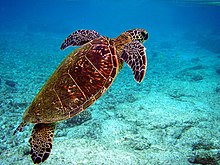 |
Endangered (central western Pacific population, USFWS)[83] | Endangered (IUCN)[84] | Native to tropical and temperate oceans[84] |
| Sei whale | Balaenoptera borealis |  |
Endangered (USWFS)[81] | Endangered (IUCN)[85] | Native throughout the oceans[85] |
| Leatherback turtle | Dermochelys coriacea |  |
Endangered (USFWS)[81] | Vulnerable (IUCN)[86] | Native to tropical and temperate oceans[86] |
| Sperm whale | Physeter macrocephalus | 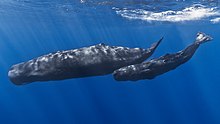 |
Endangered (USFWS)[81] | Vulnerable (IUCN)[87] | Native throughout the oceans[87] |
| False killer whale | Pseudorca crassidens |  |
Endangered (USFWS)[81] | Near Threatened (IUCN)[88] | Native throughout tropical and many temperate oceans[88] |
| Oceanic manta ray, Giant oceanic manta ray | Mobula birostris |  |
Threatened (USWFS)[81] | Endangered (IUCN)[89] | Native to tropical and temperate oceans[89] |
| Pelagic thresher | Alopias pelagicus | 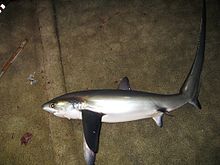 |
Endangered (IUCN)[90] | Native to Indian and Pacific Oceans[90] | |
| Basking shark | Cetorhinus maximus |  |
Endangered (IUCN)[91] | Native to Pacific and Atlantic Oceans[91] | |
| Sharptooth lemon shark | Negaprion acutidens |  |
Endangered (IUCN)[92] | Native from Middle East to Western Pacific coasts[92] | |
| Grey reef shark | Carcharhinus amblyrhynchos |  |
Endangered (IUCN)[93] | Native from tropical Indo-West and central Pacific Oceans, including the Marianas, and parts of the eastern tropical Pacific Ocean[93] | |
| Longfin mako | Isurus paucus |  |
Endangered (IUCN)[94] | Native to tropical and temperate oceans[94] | |
| Shortfin mako | Isurus oxyrinchus |  |
Endangered (IUCN)[95] | Native to tropical and temperate oceans[95] | |
| Bentfin Devil Ray | Mobula thurstoni |  |
Endangered (IUCN)[96] | Native to tropical and temperate oceans[96] | |
| Shorthorned pygmy devil ray | Mobula kuhlii |  |
Endangered (IUCN)[97] | Native to Indian Ocean and Pacific Ocean[97] | |
| Sicklefin devil ray | Mobula tarapacana |  |
Endangered (ICUN)[98] | Native to tropical and temperate oceans[98] | |
| Longhorned pygmy devil ray | Mobula eregoodoo |  |
Endangered (IUCN)[99] | Native to coastal waters from eastern Africa and Middle East to western Pacific[99] | |
| Spinetail devil ray | Mobula mobular |  |
Endangered (IUCN)[100] | Native to tropical and temperate oceans[100] | |
| Spotted eagle ray | Aetobatus ocellatus |  |
Endangered (IUCN)[101] | Native to Indian Ocean and Pacific Ocean[101] | |
| Giant wrasse | Cheilinus undulatus |  |
Endangered (IUCN)[102] | Native from Indian Ocean to Western Pacific[102] | |
| Black teatfish | Holothuria nobilis |  |
Endangered (IUCN)[103] | Native to Pacific Ocean[103] | |
| Pineapple sea cucumber, Prickly redfish | Thelenota ananas |  |
Endangered (IUCN)[104] | Native to the Indian and Pacific Oceans, including the Marianas, excluding Hawaii[104] | |
| True giant clam | Tridacna gigas |  |
2024 was proposed to be listed as endangered (USFWS)[105] | Extirpated from Guam and CNMI; Vulnerable in its extant range (IUCN)[106] | Native to western Pacific.[106] Extirpated from Guam and CNMI due to longstanding subsistence harvesting. Reintroduction attempts have had limited success. |
| Smooth giant clam | Tridacna derasa |  |
2024 was proposed to be listed as endangered (USFWS)[105] | Extirpated from Guam and CNMI; Vulnerable in its extant range (IUCN)[107] | Native to Australia; Fiji; Indonesia; New Caledonia; Palau; Papua New Guinea; Philippines; Solomon Islands; Tonga; extirpated from Guam and CNMI due to longstanding subsistence harvesting. Reintroduction attempts have had limited success.[107] |
| Horse's hoof clam | Hippopus hippopus |  |
2024 was proposed to be listed as threatened (USFWS)[105] | Extirpated from Guam and CNMI; Lower Risk: Conservation Dependent in its extant range (IUCN)[108] | Native to western Pacific islands and Australia; extirpated from Guam and CNMI due to a long history of subsistence harvesting[108] |
| Small giant clam | Tridacna maxima |  |
2024 was proposed to be listed as threatened (USFWS)[105] | Lower Risk: Conservation Dependent (IUCN)[109] | Native to Indian Ocean and Pacific Ocean[109] |
| White shark | Carcharodon carcharias | 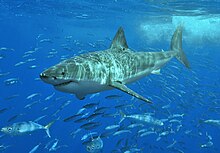 |
Vulnerable (IUCN)[110] | Native to tropical and temperate oceans[110] | |
| Blacktip reef shark | Carcharhinus melanopterus | 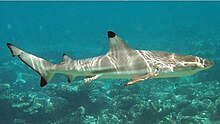 |
Vulnerable (IUCN)[111] | Native to Indian Ocean and western Pacific[111] | |
| Whitetip reef shark | Triaenodon obesus |  |
Vulnerable (IUCN)[112] | Native to Indian Ocean and western Pacific[112] | |
| Silvertip shark | Carcharhinus albimarginatus |  |
Vulnerable (IUCN)[113] | Native to Indian Ocean and Pacific Ocean[113] | |
| Bigeye thresher | Alopias superciliosus |  |
Vulnerable (IUCN)[114] | Native to many coastal areas worldwide, possibly to Guam and CNMI[114] | |
| Common thresher | Alopias vulpinus |  |
Vulnerable (IUCN)[115] | Native to many coastal areas worldwide, possibly to Guam and CNMI[115] | |
| Tawny nurse shark | Nebrius ferrugineus |  |
Vulnerable (IUCN)[116] | Native to Indian Ocean and Pacific Ocean[116] | |
| Reef manta ray | Mobula alfredi |  |
Vulnerable (IUCN)[117] | Native to Indian Ocean and Pacific Ocean[117] | |
| Blotched fantail ray | Taeniurops meyeni |  |
Vulnerable (IUCN)[118] | Native to Indian Ocean and Pacific Ocean[118] | |
| Blue marlin | Makaira nigricans |  |
Vulnerable (IUCN)[119] | Native to tropical and temperate oceans[119] | |
| Sailfish | Istiophorus platypterus |  |
Vulnerable (IUCN)[120] | Native to tropical and temperate oceans[120] | |
| Bigeye tuna | Thunnus obesus | 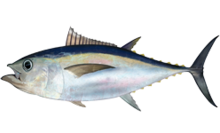 |
Vulnerable (IUCN)[121] | Native to tropical and temperate oceans[121] | |
| Camouflage grouper | Epinephelus polyphekadion |  |
Vulnerable (IUCN)[122] | Native to Indian Ocean and Pacific Ocean[122] | |
| Green humphead parrotfish | Bolbometopon muricatum |  |
Vulnerable (IUCN)[123] | Native to Indian Ocean and Pacific Ocean[123] | |
| Brown-marbled grouper | Epinephelus fuscoguttatus |  |
Vulnerable (IUCN)[124] | Native to Indian Ocean and Pacific Ocean[124] | |
| Harlequin filefish | Oxymonacanthus longirostris |  |
Vulnerable (IUCN)[125] | Native to Indian Ocean and Pacific Ocean[125] | |
| Red-striped coral goby | Gobiodon axillaris | Vulnerable[126] | Native to Indian Ocean and western Pacific Ocean[126] | ||
| Shortjaw bonefish | Albula glossodonta | Vulnerable (IUCN)[127] | Native to Indian Ocean and Pacific Ocean[127] | ||
| Ocean sunfish | Mola mola | 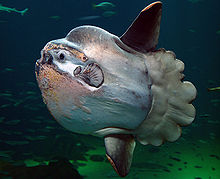 |
Vulnerable (IUCN)[128] | Native to tropical and temperate oceans[128] | |
| Actinopyga echinites | 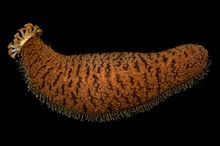 |
Vulnerable (IUCN)[129] | Native to tropical and temperate oceans[129] | ||
| Actinopyga mauritiana |  |
Vulnerable (IUCN)[130] | Native to Indian Ocean and eastern Pacific Ocean[130] | ||
| Actinopyga miliaris |  |
Vulnerable (IUCN)[131] | Native to Indian Ocean and Pacific Ocean[131] | ||
| Holothuria fuscogilva |  |
Vulnerable (IUCN)[132] | Native to Indian Ocean and Pacific Ocean[132] |
In 2024, USFWS proposed 10 species of clam be protected under the Endangered Species Act (ESA), of which the following are native to the Mariana Islands:
- Smooth giant clam (Tridacna derasa) - extirpated from Guam and CNMI; see above. Proposed to be listed as endangered under the ESA.
- True giant clam (Tridacna gigas) - extirpated from Guam and CNMI; see above. Proposed to be listed as endangered under the ESA.
- Horse's hoof clam (Hippopus hippopus) - extirpated from Guam and CNMI; see above. Proposed to be listed as threatened under the ESA.
- Maxima clam (Tridacna maxima) - native to Indian Ocean and Pacific Ocean, and is the most giant clam species found on Guam and CNMI.[133] Proposed to be listed as threatened under the ESA.
- Tridacna crocea - possibly extinct from Guam and CNMI.[134] Proposed to be listed as threatened under the ESA.
In addition, the fluted giant clam (Tridacna squamosa), is proposed to be listed as endangered. Sources vary as to whether it is an introduced (non-native)[105][135] or native species[136] in the Marianas, but it remains rare on Guam (<10 individuals per hectare) and is not present in the CNMI. It was determined by the USFWS to not be at risk of extinction in its native range in the foreseeable future, but nonetheless was proposed to be listed as threatened under the ESA due to the similarity of products from this species as from the other species listed above.
- Shortfin eel (Anguilla bicolor)
- Redeye goby (Bryaninops natans)
- Chevron butterflyfish (Chaetodon trifascialis)
- Deshayesiella sirenkoi - endemic to deep ocean off the Bonin and Mariana Islands
- Tiger shark (Galeocerdo cuvier)
- Ceram coralgoby (Gobiodon ceramensis)
- Bombay duck lizardfish (Harpadon nehereus)
- Oenopota ogasawarana - endemic to deep ocean off the Mariana Islands
- Pachydermia sculpta
- Dick's damsel (Plectroglyphidodon dickii)
- Blue shark (Prionace glauca)
- Narrow-barred Spanish mackerel (Scomberomorus commerson)
- Shinkailepas kaikatensis - endemic to hydrothermal vents off the Mariana Islands
- Pacific bluefin tuna (Thunnus orientalis)
- Swordfish (Xiphias gladius)
Corals
[edit]| Common name | Scientific name | Image | US Fish & Wildlife conservation status | IUCN Red List status | Notes |
|---|---|---|---|---|---|
| Anacropora spinosa | Threatened (USFWS)[81] | Endangered (IUCN)[138] | Native to Southeast Asia and southwestern Pacific Ocean[138] | ||
| Porites eridani | Endangered (IUCN)[139] | Native to Southeast Asia and southwestern Pacific Ocean[139] | |||
| Acropora globiceps |  |
Threatened (USFWS)[81] | Vulnerable (IUCN)[140] | Native to southeast Asia and Pacific ocean[140] | |
| Pavona diffluens | Threatened (USFWS)[81] | Vulnerable (IUCN)[141] | Native to Middle Eastern Indian Ocean, India, and Micronesia[141] | ||
| Acropora tenella | Threatened (USFWS)[81] | Vulnerable (IUCN)[142] | Native to southeast Asia, Mariana Islands and Papua New Guinea[142] | ||
| Porites napopora | Threatened (USFWS)[81] | Vulnerable (IUCN)[143] | Native to Southeast Asia and Micronesia[143] | ||
| Porites napopora | Threatened (USFWS)[81] | Vulnerable (IUCN)[143] | Native to Southeast Asia and Micronesia[143] | ||
| Seriatopora aculeata | Threatened (USFWS)[81] | Vulnerable (IUCN)[144] | Native to Indian Ocean and Pacific Ocean[144] | ||
| Seriatopora aculeata | Threatened (USFWS)[81] | Vulnerable (IUCN)[144] | Native to Indian Ocean and Pacific Ocean[144] | ||
| Acanthastrea brevis | Vulnerable (IUCN)[145] | Native to Indian Ocean and western Pacific Ocean[145] | |||
| Acropora aculeus | 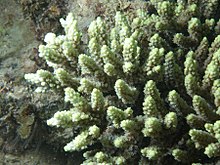 |
Vulnerable (IUCN)[146] | Native to Indian Ocean and Pacific Ocean[146] | ||
| Acropora acuminata |  |
Vulnerable (IUCN)[147] | Native to Indian Ocean and Pacific Ocean[147] | ||
| Acropora aspera |  |
Vulnerable (IUCN)[148] | Native to Indian Ocean and western Pacific Ocean[148] | ||
| Acropora listeri |  |
Vulnerable (IUCN)[149] | Native to Indian Ocean and Pacific Ocean[149] | ||
| Acropora lovelli | Vulnerable (IUCN)[150] | Native to Indian Ocean and Pacific Ocean[150] | |||
| Acropora palmerae |  |
Vulnerable (IUCN)[151] | Native to Indian Ocean and Pacific Ocean[151] | ||
| Acropora striata | Vulnerable (IUCN)[152] | Native to southeast Asia and western Pacific Ocean[152] | |||
| Acropora vaughani |  |
Vulnerable (IUCN)[153] | Native to Indian Ocean and Pacific Ocean[153] | ||
| Acropora verweyi |  |
Vulnerable (IUCN)[154] | Native to Indian Ocean and Pacific Ocean[154] | ||
| Alveopora allingi | Vulnerable (IUCN)[155] | Native to Indian Ocean and Pacific Ocean[155] | |||
| Alveopora fenestrata | Vulnerable (IUCN)[156] | Native to Indian Ocean and western Pacific Ocean[156] | |||
| Alveopora verrilliana |  |
Vulnerable (IUCN)[157] | Native to Indian Ocean and Pacific Ocean[157] | ||
| Anacropora puertogalerae | Vulnerable (IUCN)[158] | Native to Indian Ocean and western Pacific Ocean[158] | |||
| Cyphastrea agassizi | Vulnerable (IUCN)[159] | Native to southeast Asia and Pacific Ocean[159] | |||
| Dipsastraea laddi | Vulnerable (IUCN)[160] | Native to southeast Asia and Pacific Ocean[160] | |||
| Euphyllia cristata |  |
Vulnerable (IUCN)[161] | Native to Indian Ocean and western Pacific Ocean[161] | ||
| Fimbriaphyllia paraancora | Vulnerable (IUCN)[162] | Native to eastern Indian Ocean and western Pacific Ocean[163] | |||
| Isopora cuneata | Vulnerable (IUCN)[164] | Native to Indian Ocean and western Pacific Ocean[164] | |||
| Leptoseris incrustans | 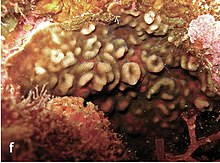 |
Vulnerable (IUCN)[165] | Native to eastern Indian Ocean and western Pacific Ocean[165] | ||
| Lobophyllia ishigakiensis | Vulnerable (IUCN)[166] | Native to Indian Ocean and western Pacific Ocean[166] | |||
| Micromussa regularis |  |
Vulnerable (IUCN)[167] | Native to eastern Indian Ocean and western Pacific Ocean[167] | ||
| Montipora caliculata |  |
Vulnerable (IUCN)[168] | Native to Indian Ocean and Pacific Ocean[168] | ||
| Montipora lobulata | Vulnerable (IUCN)[163] | Native to Indian Ocean and Pacific Ocean[163] | |||
| Pachyseris rugosa |  |
Vulnerable (IUCN)[169] | Native to Indian Ocean and Pacific Ocean[169] | ||
| Pavona cactus |  |
Vulnerable (IUCN)[170] | Native to Indian Ocean and Pacific Ocean[170] | ||
| Pavona bipartita |  |
Vulnerable (IUCN)[171] | Native to Indian Ocean and Pacific Ocean[171] | ||
| Pavona decussata |  |
Vulnerable (IUCN)[172] | Native to Indian Ocean and Pacific Ocean[172] | ||
| Pavona venosa |  |
Vulnerable (IUCN)[173] | Native to Indian Ocean and western Pacific Ocean[173] | ||
| Pectinia alcicornis |  |
Vulnerable (IUCN)[174] | Native to southeast Asia and western Pacific Ocean[174] | ||
| Psammocora stellata |  |
Vulnerable (IUCN)[175] | Native to Indian Ocean and Pacific Ocean to American coast.[175] | ||
| Physogyra lichtensteini | Vulnerable (IUCN)[176] | Native to Indian Ocean and Pacific Ocean[176] | |||
| Pocillopora elegans |  |
Vulnerable (IUCN)[177] | Native to Southeast Asia through Pacific to American coast[177] | ||
| Pocillopora verrucosa (synonym: Pocillopora danae) |  |
Vulnerable (IUCN)[178] | Native to Pacific Ocean[178] | ||
| Porites horizontalata | Vulnerable (IUCN)[179] | Native to Indian Ocean and western Pacific Ocean[179] | |||
| Porites nigrescens | Vulnerable (IUCN)[180] | Native to Indian Ocean and western Pacific Ocean[180] | |||
| Turbinaria mesenterina | Vulnerable (IUCN)[181] | Native to Indian Ocean and western Pacific Ocean[144] | |||
| Turbinaria reniformis |  |
Vulnerable (IUCN)[182] | Native to Indian Ocean and Pacific Ocean[182] | ||
| Turbinaria stellulata |  |
Vulnerable (IUCN)[183] | Native to Indian Ocean and Pacific Ocean[163] |
- Acanthastrea hillae
- Acanthastrea rotundoflora
- Acropora digitifera
- Branch coral (Acropora florida)
- Staghorn coral (Acropora formosa)
- Acropora granulosa
- Finger coral (Acropora humilis)
- Acropora loripes
- Acropora millepora
- Acropora nasuta
- Acropora secale
- Acropora lutkeni
- Acropora monticulosa
- Acropora tenuis
- Alveopora spongiosa
- Alveopora viridis
- Astraeosmilia maxima
- Coelastrea palauensis
- Ctenactis albitentaculata
- Diploastrea heliopora
- Dipsastraea helianthoides
- Dipsastraea maritima
- Dipsastraea marshae
- Dipsastraea matthaii
- Torch coral (Euphyllia glabrescens)
- Favites abdita
- Favites colemani
- Favites halicora
- Favites flexuosa
- Favites magnistellata
- Favites valenciennesii
- Common mushroom coral (Fungia fungites)
- Galaxea fascicularis
- Galaxea paucisepta
- Goniastrea stelligera
- Goniopora columna
- Goniopora lobata
- Goniopora minor
- Hydnophora exesa
- Hydnophora microconos
- Catch bowl coral (Isopora palifera)
- Leptastrea bottae
- Leptoria phrygia
- Merulina triangularis
- Micromussa amakusensis
- Montipora efflorescens
- Montipora foliosa
- Montipora foveolata
- Montipora venosa
- Intermediate valley coral (Oulophyllia crispa)
- Paragoniastrea russelli
- Pavona minuta
- Pectinia paeonia
- Platygyra ryukyuensis
- Plerogyra simplex
- Bubble coral (Plerogyra sinuosa)
- Pocillopora eydouxi
- Porites annae
- Porites cylindrica
- Porites densa
- Porites lobata
- Porites murrayensis
- Porites stephensoni
- Psammocora contigua
- Psammocora digitata
- Psammocora obtusangula
- Psammocora vaughani
- Birdsnest coral (Seriatopora caliendrum)
- Seriatopora stellata
- Smooth cauliflower coral (Stylophora pistillata)
Crustaceans
[edit]| Common name | Scientific name | Image | US Fish & Wildlife conservation status | IUCN Red List status | Notes |
|---|---|---|---|---|---|
| Coconut crab | Birgus latro | 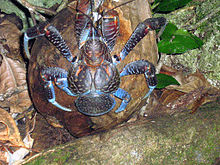 |
Vulnerable (IUCN)[184] | Native to Indian Ocean and eastern Pacific Ocean[184] |
Recovered species
[edit]| Common name | Scientific name | Image | US Fish & Wildlife conservation status | IUCN Red List status | Notes |
|---|---|---|---|---|---|
| Tinian monarch | Monarcha takatsukasae |  |
On the USFWS endangered species list since 1970 but delisted in 2004 due to recovery of population.[185] In 2013, the Center for Biological Diversity petitioned for the species to again be listed as endangered, but the USFWS determined that protected status was not warranted.[186] | Near Threatened (IUCN)[187] | Native to Tinian, and introduced to Guguan |
References
[edit]- ^ "Endangered and Threatened Wildlife and Plants; Endangered Status for 16 Species and Threatened Status for 7 Species in Micronesia" (PDF). DEPARTMENT OF THE INTERIOR: Fish and Wildlife Service. 2015. Retrieved 2024-08-31.
- ^ "Search: EX - Extinct; Guam + Northern Mariana Islands; Species". IUCN Red List.
- ^ a b Kerr, Alexander (2013). "Partula desolata sp. nov. (Pulmonata: Partulidae), an extinct land snail from Rota, Mariana Islands, Micronesia". Micronesica. 05: 2 – via Academia.
- ^ a b Steadman, David W. "Extinct and Extirpated Birds from Rota, Mariana Islands". Micronesica. 25 (1): 71–84.
- ^ "Search: EW - Extinct in the wild; Guam + Northern Mariana Islands; Species". IUCN Red List. Retrieved 2024-09-02.
- ^ a b c "21 Species Delisted from the Endangered Species Act due to Extinction | U.S. Fish & Wildlife Service". www.fws.gov. 2023-10-16. Retrieved 2024-08-31.
- ^ "Guam Flying Fox - Pteropus tokudae". IUCN Red List. 2020. Retrieved 2024-09-27.
- ^ a b "Endangered and Threatened Wildlife and Plants; Initiation of 5-Year Status Reviews for 133 Species in Oregon, Washington, Idaho, Montana, California, Nevada, Hawaii, Guam, and the Commonwealth of the Northern Mariana Islands". Federal Register. 2023-03-23. Retrieved 2024-08-31.
- ^ "Pacific Sheath-tailed Bat - Emballonura semicaudata". IUCN Red List. Retrieved 2024-09-07.
- ^ a b "Initiation of 5-Year Status Reviews for 156 Species in Oregon, Washington, Hawaii, Palau, Guam, and the Northern Mariana Islands | U.S. Fish & Wildlife Service". www.fws.gov. 2018-05-07. Retrieved 2024-09-07.
- ^ "Mariana Fruit Bat - Pteropus mariannus". IUCN Red List. 2020. Retrieved 2024-09-07.
- ^ a b "Endangered and Threatened Wildlife and Plants; Initiation of 5-Year Status Reviews for 167 Species in Oregon, Washington, Idaho, Montana, California, Hawaii, Guam, and the Northern Mariana Islands". Federal Register. 2022-05-10. Retrieved 2024-09-27.
- ^ "Mariana Skink - Emoia slevini". IUCN Red List. 2013. Retrieved 2024-09-04.
- ^ a b "Micronesia Saw-tailed Gecko - Perochirus ateles". IUCN Red List. 2017. Retrieved 2024-09-28.
- ^ a b "Native Forest Birds of Guam - Guampedia". www.guampedia.com. 2009-09-30. Retrieved 2024-09-29.
- ^ "Pagan Reed-warbler - Acrocephalus yamashinae". IUCN Red List. 2023. Retrieved 2024-09-02.
- ^ "Pagan Reed Warbler - eBird". ebird.org. Retrieved 2024-09-02.
- ^ a b c "Removing the Mariana Mallard and the Guam Broadbill From the Federal List of Endangered and Threatened Wildlife | U.S. Fish & Wildlife Service". www.fws.gov. 2004-02-23. Retrieved 2024-09-02.
- ^ "Bridled White-eye - Zosterops conspicillatus". IUCN Red List. 2023. Retrieved 2024-09-29.
- ^ "Endangered and Threatened Wildlife and Plants; Removal of 21 Species From the List of Endangered and Threatened Wildlife". Federal Register. 2023-10-17. Retrieved 2024-08-31.
- ^ "Aguijan Reed-warbler - Acrocephalus nijoi". IUCN Red List. 2023. Retrieved 2024-09-02.
- ^ "Aguiguan Reed Warbler - eBird". ebird.org. Retrieved 2024-09-02.
- ^ "Guam Flycatcher - Myiagra freycineti". IUCN Red List. 2016. Retrieved 2024-09-02.
- ^ "Species profile for Nightingale reed warbler (old world warbler) (Acrocephalus luscinia)". ECOS (Environmental Conservation Online System). Retrieved 2024-09-29.
- ^ "Guam Reed-warbler - Acrocephalus luscinius". IUCN Red List. 2023. Retrieved 2024-09-04.
- ^ a b c d e f g h i j k l m n o p q r s t u v w x "Federal Register, Volume 88 Issue 64 (Tuesday, April 4, 2023) 2023 Federal Register, 88 FR 19880-19894; Centralized Library: U.S. Fish and Wildlife Service -". www.fws.gov. Retrieved 2024-08-31.
- ^ "Nightingale Reed-warbler - Pacific Bird Conservation". 2015-09-21. Archived from the original on 2015-09-21. Retrieved 2024-09-29.
- ^ a b c d e f g h i "Endangered and Threatened Wildlife and Plants; Technical Corrections for 62 Wildlife and Plant Species on the Lists of Endangered and Threatened Wildlife and Plants". Federal Register. 2023-02-02. Retrieved 2024-08-31.
- ^ "Guam Kingfisher - Todiramphus cinnamominus". IUCN Red List. 2017. Retrieved 2024-09-02.
- ^ "Guam Rail - Hypotaenidia owstoni". IUCN Red List. 2019. Retrieved 2024-08-31.
- ^ a b "Saipan Reed-warbler - Acrocephalus hiwae". IUCN Red List. 2018. Retrieved 2024-09-04.
- ^ "Acrocephalus hiwae (Saipan Reed-Warbler) - Avibase". avibase.bsc-eoc.org. Retrieved 2024-09-29.
- ^ a b "Rota White-eye - Zosterops rotensis". IUCN Red List. 2018. Retrieved 2024-09-04.
- ^ a b "Mariana Crow - Corvus kubaryi". IUCN Red List. 2018. Retrieved 2024-09-04.
- ^ a b "Micronesian Scrubfowl - Megapodius laperouse". IUCN Red List. Retrieved 2024-09-28.
- ^ "Mariana Swiftlet - Aerodramus bartschi". IUCN Red List. 2023. Retrieved 2024-09-25.
- ^ a b "Golden White-eye - Cleptornis marchei". IUCN Red List. 2020. Retrieved 2024-09-03.
- ^ a b "Saipan White-eye - Zosterops saypani". IUCN Red List. 2022. Retrieved 2024-09-29.
- ^ a b "Mariana Fruit-dove - Ptilinopus roseicapilla". IUCN Red List. Retrieved 2024-09-28.
- ^ "White-throated Ground-dove - Pampusana xanthonura". IUCN Red List. 2023. Retrieved 2024-09-29.
- ^ "Short-tailed Albatross (Phoebastria albatrus) | U.S. Fish & Wildlife Service". www.fws.gov. Retrieved 2024-09-02.
- ^ a b "Short-tailed Albatross - Phoebastria albatrus". IUCN Red List. 2018. Retrieved 2024-09-03.
- ^ a b "Far Eastern Curlew - Numenius madagascariensis". IUCN Red List. 2017. Retrieved 2024-09-25.
- ^ a b "Siberian Sandplover - Charadrius mongolus". IUCN Red List. 2023. Retrieved 2024-09-25.
- ^ a b "White-necked Petrel - Pterodroma cervicalis". IUCN Red LIst. 2018. Retrieved 2024-09-25.
- ^ a b "Juan Fernandez Petrel - Pterodroma externa". IUCN Red LIst. 2018. Retrieved 2024-09-25.
- ^ a b "Stejneger's Petrel - Pterodroma longirostris". IUCN Red List. 2019. Retrieved 2024-09-25.
- ^ a b "Common Pochard - Aythya ferina". IUCN Red List. 2021. Retrieved 2024-09-25.
- ^ a b "Sharp-tailed Sandpiper - Calidris acuminata". IUCN Red List. 2022. Retrieved 2024-09-27.
- ^ a b "Hydrobates leucorhous". IUCN Red List. 2018. Retrieved 2024-09-27.
- ^ a b "Matsudaira's Storm-petrel - Hydrobates matsudairae". IUCN Red List. Retrieved 2024-09-28.
- ^ a b "Bar-tailed Godwit - Limosa lapponica". IUCN Red List. 2017. Retrieved 2024-09-25.
- ^ a b "Grey-tailed Tattler - Tringa brevipes". IUCN Red List. 2016. Retrieved 2024-09-28.
- ^ a b Sischo, David R.; Hadfield, Michael G. (2021-05-17). "The tree snail on Rota Island, Northern Mariana Islands, long identified as Partula gibba (Partulidae), is a different species". ZooKeys (1037): 105–118. Bibcode:2021ZooK.1037..105S. doi:10.3897/zookeys.1037.56303. ISSN 1313-2970. PMC 8144162. PMID 34054316.
- ^ a b "Mount Alifana Partula - Partula salifana". IUCN Red List. 2017. Retrieved 2024-08-31.
- ^ a b c d e f g h i j k l m n o p q r s t u v w x y z aa ab ac ad ae af ag ah "Endangered and Threatened Wildlife and Plants; Initiation of 5-Year Status Reviews for 167 Species in Oregon, Washington, Idaho, Montana, California, Hawaii, Guam, and the Northern Mariana Islands". Federal Register. 2022-05-10. Retrieved 2024-08-31.
- ^ "Partula langfordi". IUCN Red List. 2024. Retrieved 2024-09-02.
- ^ a b "[Unnamed] snail (Succinea piratarum)". Environmental Conservation Online System (ECOS), Federal Register. 1994. p. 259. Retrieved 2024-09-25.
- ^ a b "Succinea quadrasi". IUCN Red List. 1996. Retrieved 2024-09-25.
- ^ a b "Succinea piratarum". IUCN Red List. 1996. Retrieved 2024-09-25.
- ^ a b c d "Endangered and Threatened Wildlife and Plants; Initiation of 5-Year Status Reviews for 100 Species in American Sāmoa, California, Hawaii, Idaho, Oregon, and Washington". Federal Register. 2024-03-20. Retrieved 2024-08-31.
- ^ "Fragile Tree Snail - Samoana fragilis". IUCN Red List. 2024. Retrieved 2024-09-07.
- ^ "Fat Guam Partula - Partula gibba". IUCN Red List. 2024. Retrieved 2024-09-07.
- ^ "Guam Tree Snail - Partula radiolata". IUCN Red List. 2024. Retrieved 2024-09-07.
- ^ a b "Ischnura luta". IUCN Red List. 2020. Retrieved 2024-09-28.
- ^ "Serianthes nelsonii". IUCN Red List. 2017. Retrieved 2024-09-04.
- ^ "Osmoxylon mariannense". IUCN Red List. 1998. Retrieved 2024-09-04.
- ^ "Heritiera longipetiolata". IUCN Red List. 1998. Retrieved 2024-09-28.
- ^ "Fadan - Cycas micronesica". IUCN Red List. 2022. Retrieved 2024-09-02.
- ^ "Terminalia rostrata". IUCN Red List. 2024. Retrieved 2024-09-27.
- ^ "Terminalia rostrata Fosberg & Falanruw | Plants of the World Online | Kew Science". Plants of the World Online. Retrieved 2024-09-27.
- ^ "Pterocarpus indicus". IUCN Red List. 2018. Retrieved 2024-09-07.
- ^ "Pterocarpus indicus Willd. | Plants of the World Online | Kew Science". Plants of the World Online. Retrieved 2024-09-07.
- ^ "Aglaia mariannensis". IUCN Red List. 1998. Retrieved 2024-09-27.
- ^ "Aglaia mariannensis Merr. | Plants of the World Online | Kew Science". Plants of the World Online. Retrieved 2024-09-27.
- ^ a b "Merbau - Intsia bijuga". IUCN Red List. 2020. Retrieved 2024-09-28.
- ^ Lorence, David H.; Wagner, Warren L.; Wood, Kenneth R.; Johnson, Gabriel (2020-12-04). "Pogostemon guamensis Lorence & W.L.Wagner (Lamiaceae), a new species from Guam, Mariana Islands". PhytoKeys (169): 61–73. doi:10.3897/phytokeys.169.58107. ISSN 1314-2003. PMC 7732819. PMID 33354139.
- ^ Deloso, Benjamin E.; Paulino, Charles A.; Cootes, Jim (2022). "A new species of Bulbophyllum(Orchidaceae) from the Mariana Islands of Guam und Rota". OrchideenJournal. 2: 55–56.
- ^ "Hawksbill sea turtle (Eretmochelys imbricata)". U.S. Fish & Wildlife Service: ECOS Environmental Conservation Online System. Retrieved 2024-09-02.
- ^ a b "Hawksbill Turtle - Eretmochelys imbricata". IUCN Red List. 2008. Retrieved 2024-09-03.
- ^ a b c d e f g h i j k l m n Fisheries, NOAA. "Species Directory - ESA Threatened & Endangered | NOAA Fisheries". www.fisheries.noaa.gov. Retrieved 2024-09-30.
- ^ a b "Oceanic Whitetip Shark - Carcharhinus longimanus". IUCN Red List. 2019. Retrieved 2024-09-03.
- ^ "Endangered and Threatened Wildlife and Plants; Designation of Critical Habitat for Green Sea Turtle | U.S. Fish & Wildlife Service". www.fws.gov. 2023-07-19. Retrieved 2024-09-02.
- ^ a b "Green Turtle - Chelonia mydas". IUCN Red List. 2023. Retrieved 2024-09-25.
- ^ a b "Sei Whale - Balaenoptera borealis". IUCN Red List. 2018. Retrieved 2024-09-25.
- ^ a b "Leatherback Turtle - Dermochelys coriacea". IUCN Red List. 2013. Retrieved 2024-09-25.
- ^ a b "Sperm Whale - Physeter macrocephalus". IUCN Red List. 2019. Retrieved 2024-09-25.
- ^ a b "False Killer Whale - Pseudorca crassidens". IUCN Red List. 2018. Retrieved 2024-09-30.
- ^ a b "Oceanic Manta Ray - Mobula birostris". IUCN Red List. 2022. Retrieved 2024-09-03.
- ^ a b "Pelagic Thresher - Alopias pelagicus". IUCN Red List. 2019. Retrieved 2024-09-03.
- ^ a b "Basking Shark - Cetorhinus maximus". IUCN Red List. 2021. Retrieved 2024-09-03.
- ^ a b "Sharptooth Lemon Shark - Negaprion acutidens". IUCN Red List. 2021. Retrieved 2024-09-07.
- ^ a b "Grey Reef Shark - Carcharhinus amblyrhynchos". IUCN Red List. 2020. Retrieved 2024-08-31.
- ^ a b "Longfin Mako - Isurus paucus". IUCN Red List. 2019. Retrieved 2024-09-07.
- ^ a b "Shortfin Mako - Isurus oxyrinchus". IUCN Red List. 2019. Retrieved 2024-09-25.
- ^ a b "Bentfin Devil Ray - Mobula thurstoni". IUCN Red List. 2022. Retrieved 2024-09-25.
- ^ a b "Shorthorned Pygmy Devil Ray - Mobula kuhlii". IUCN Red List. 2022. Retrieved 2024-09-07.
- ^ a b "Sicklefin Devil Ray - Mobula tarapacana". IUCN Red List. 2022. Retrieved 2024-09-07.
- ^ a b "Longhorned Pygmy Devil Ray - Mobula eregoodoo". IUCN Red List. 2022. Retrieved 2024-09-07.
- ^ a b "Spinetail Devil Ray - Mobula mobular". IUCN Red List. 2022. Retrieved 2024-09-25.
- ^ a b "Spotted Eagle Ray - Aetobatus ocellatus". IUCN Red List. 2024. Retrieved 2024-09-25.
- ^ a b "Giant Wrasse - Cheilinus undulatus". IUCN Red List. 2004. Retrieved 2024-09-25.
- ^ a b "Black Teatfish - Holothuria nobilis". IUCN Red List. 2013. Retrieved 2024-09-07.
- ^ a b "Pineapple Sea Cucumber - Thelenota ananas". IUCN Red List. 2013. Retrieved 2024-08-31.
- ^ a b c d e f "Endangered and Threatened Wildlife and Plants; Proposed Listing Determinations for Ten Species of Giant Clams Under the Endangered Species Act". Federal Register. 2024-07-25. Retrieved 2024-10-04.
- ^ a b "Giant Clam - Tridacna gigas". IUCN Red List. Retrieved 2024-09-28.
- ^ a b "Tridacna derasa". IUCN Red List. 1996. Retrieved 2024-09-28.
- ^ a b "Hippopus hippopus". IUCN Red List. 1996. Retrieved 2024-09-28.
- ^ a b "Tridacna maxima". IUCN Red List. 1996. Retrieved 2024-09-28.
- ^ a b "White Shark - Carcharodon carcharias". IUCN Red List. 2022. Retrieved 2024-09-25.
- ^ a b "Blacktip Reef Shark - Carcharhinus melanopterus". IUCN Website. 2020. Retrieved 2024-09-25.
- ^ a b "Whitetip Reef Shark - Triaenodon obesus". IUCN Red List. 2020. Retrieved 2024-09-27.
- ^ a b "Silvertip Shark - Carcharhinus albimarginatus". IUCN Red List. 2024. Retrieved 2024-09-28.
- ^ a b "Alopias superciliosus". IUCN Red List. 2019. Retrieved 2024-09-28.
- ^ a b "Common Thresher - Alopias vulpinus". IUCN Red List. 2022. Retrieved 2024-09-28.
- ^ a b "Tawny Nurse Shark - Nebrius ferrugineus". IUCN Red List. Retrieved 2024-09-28.
- ^ a b "Reef Manta Ray - Mobula alfredi". IUCN Red List. 2022. Retrieved 2024-09-25.
- ^ a b "Blotched Fantail Ray - Taeniurops meyeni". IUCN Red List. 2024. Retrieved 2024-09-27.
- ^ a b "Blue Marlin - Makaira nigricans". IUCN Red LIst. 2022. Retrieved 2024-09-25.
- ^ a b "Sailfish - Istiophorus platypterus". IUCN Red List. 2022. Retrieved 2024-09-25.
- ^ a b "Thunnus obesus". IUCN Red List. 2021. Retrieved 2024-09-28.
- ^ a b "Camouflage Grouper - Epinephelus polyphekadion". IUCN Red List. 2018. Retrieved 2024-09-25.
- ^ a b "Green Humphead Parrotfish - Bolbometopon muricatum". IUCN Red List. 2012. Retrieved 2024-09-27.
- ^ a b "Epinephelus fuscoguttatus". IUCN Red List. 2018. Retrieved 2024-09-27.
- ^ a b "Oxymonacanthus longirostris". IUCN Red List. 2016. Retrieved 2024-09-27.
- ^ a b "Gobiodon axillaris". IUCN Red List. Retrieved 2024-09-28.
- ^ a b "Albula glossodonta: Adams, A., Guindon, K., Horodysky, A., MacDonald, T., McBride, R., Shenker, J. & Ward, R." IUCN Red List of Threatened Species. 2011-03-29. doi:10.2305/iucn.uk.2012.rlts.t194299a2310398.en. Retrieved 2024-09-27.
- ^ a b "Ocean Sunfish - Mola mola". IUCN Red List. 2015. Retrieved 2024-09-25.
- ^ a b "Actinopyga echinites". IUCN Red List. 2013. Retrieved 2024-09-27.
- ^ a b "Actinopyga mauritiana". IUCN Red List. 2013. Retrieved 2024-09-28.
- ^ a b "Actinopyga miliaris". IUCN Red List. 2013. Retrieved 2024-09-28.
- ^ a b "Holothuria fuscogilva". IUCN Red List. 2013. Retrieved 2024-09-28.
- ^ "Small Giant Clam - Tridacna maxima". IUCN Red List. 1996. Retrieved 2024-10-04.
- ^ "Tridacna crocea". IUCN Red List. 1996. Retrieved 2024-10-04.
- ^ "Tridacna squamosa". IUCN Red List. 1996. Retrieved 2024-10-04.
- ^ "Hima: Conserving a Cultural Heritage - Guampedia". www.guampedia.com. 2017-08-04. Retrieved 2024-10-04.
- ^ a b "Search: species listed as Near Threatened in Guam and Northern Mariana Islands". IUCN Red List. Retrieved 2024-09-29.
- ^ a b "Anacropora spinosa". IUCN Red List. 2014. Retrieved 2024-09-25.
- ^ a b "Porites eridan". IUCN Red List. 2014. Retrieved 2024-09-07.
- ^ a b "Acropora globiceps". IUCN Red List. 2014. Retrieved 2024-09-28.
- ^ a b "Pavona diffluens". IUCN Red List. 2014. Retrieved 2024-09-28.
- ^ a b "Acropora tenella". IUCN Red List. 2014. Retrieved 2024-09-28.
- ^ a b c d "Porites napopora". IUCN Red List. 2014. Retrieved 2024-09-28.
- ^ a b c d e "Seriatopora aculeata". IUCN Red List. 2014. Retrieved 2024-09-27.
- ^ a b "Acanthastrea brevis". IUCN Red List. 2014. Retrieved 2024-09-28.
- ^ a b "Acropora aculeus". IUCN Red List. 2014. Retrieved 2024-09-28.
- ^ a b "Acropora acuminata". IUCN Red List. 2014. Retrieved 2024-09-27.
- ^ a b "Acropora aspera". IUCN Red List. 2014. Retrieved 2024-09-28.
- ^ a b "Acropora listeri". IUCN Red List. 2014. Retrieved 2024-09-28.
- ^ a b "Acropora lovelli". IUCN Red List. 2014. Retrieved 2024-09-28.
- ^ a b "Acropora palmerae". IUCN Red List. 2014. Retrieved 2024-09-28.
- ^ a b "Acropora striata". IUCN Red List. 2014. Retrieved 2024-09-28.
- ^ a b "Acropora vaughani". IUCN Red List. 2014. Retrieved 2024-09-27.
- ^ a b "Acropora verweyi". IUCN Red List. 2014. Retrieved 2024-09-28.
- ^ a b "Alveopora allingi". IUCN Red List. 2014. Retrieved 2024-09-28.
- ^ a b "Alveopora fenestrata". IUCN Red List. 2014. Retrieved 2024-09-28.
- ^ a b "Alveopora verrilliana". IUCN Red List. Retrieved 2024-09-28.
- ^ a b "Anacropora puertogalerae". IUCN Red List. 2014. Retrieved 2024-09-28.
- ^ a b "Cyphastrea agassizi". IUCN Red List. 2014. Retrieved 2024-09-28.
- ^ a b "Barabattoia laddi". IUCN Red List. 2014. Retrieved 2024-09-27.
- ^ a b "Euphyllia cristata". IUCN Red List. 2014. Retrieved 2024-09-28.
- ^ "Fimbriaphyllia paraancora". IUCN Red List. 2014. Retrieved 2024-09-27.
- ^ a b c d "Montipora lobulata". IUCN Red List. 2014. Retrieved 2024-09-27.
- ^ a b "Isopora cuneata". IUCN Red List. 2014. Retrieved 2024-09-28.
- ^ a b "Leptoseris incrustans". IUCN Red List. 2014. Retrieved 2024-09-28.
- ^ a b "Lobophyllia ishigakiensis". IUCN Red List. Retrieved 2024-09-28.
- ^ a b "Micromussa regularis". IUCN Red List. 2014. Retrieved 2024-09-28.
- ^ a b "Montipora caliculata". IUCN Red List. 2014. Retrieved 2024-09-27.
- ^ a b "Pachyseris rugosa". IUCN Red List. 2014. Retrieved 2024-09-27.
- ^ a b "Pavona cactus". IUCN Red List. Retrieved 2024-09-27.
- ^ a b "Pavona bipartita". IUCN Red List. 2014. Retrieved 2024-09-27.
- ^ a b "Pavona decussata". IUCN Red List. 2014. Retrieved 2024-09-27.
- ^ a b "Pavona venosa". IUCN Red List. Retrieved 2024-09-28.
- ^ a b "Pectinia alcicornis". IUCN Red List. 2014. Retrieved 2024-09-28.
- ^ a b "Psammocora stellata". IUCN Red List. 2014. Retrieved 2024-09-28.
- ^ a b "Physogyra lichtensteini". IUCN Red List. 2014. Retrieved 2024-09-28.
- ^ a b "Pocillopora elegans". IUCN Red List. 2014. Retrieved 2024-09-28.
- ^ a b "Pocillopora danae". IUCN Red List. 2014. Retrieved 2024-09-27.
- ^ a b "Porites horizontalata". IUCN Red List. 2014. Retrieved 2024-09-28.
- ^ a b "Porites nigrescens". IUCN Red List. 2014. Retrieved 2024-09-28.
- ^ "Turbinaria mesenterina". IUCN Red List. Retrieved 2024-09-28.
- ^ a b "Turbinaria reniformis". IUCN Red List. 2014. Retrieved 2024-09-28.
- ^ "Turbinaria stellulata". IUCN Red List. 2014. Retrieved 2024-09-28.
- ^ a b "Coconut Crab - Birgus latro". IUCN Red List. 2020. Retrieved 2024-09-28.
- ^ "Tinian Monarch (old world flycatcher) (Monarcha takatsukasae)". U.S. Fish & Wildlife Service: ECOS Environmental Conservation Online System. Retrieved 2024-09-02.
- ^ "83 FR 65127 65134: 12-Month Findings on Petitions to List 13 Species as Endangered or Threatened Species; Notice of 12-month petition findings". ECOS (Environmental Conservation Online System): Tinian Monarch (old world flycatcher) (Monarcha takatsukasae). 2018-12-19. Retrieved 2024-09-29.
- ^ "Monarcha takatsukasae". IUCN Red List. 2022. Retrieved 2024-09-28.

